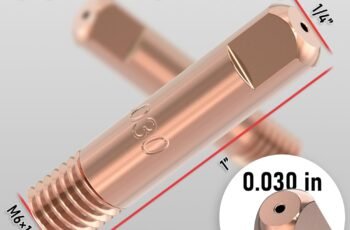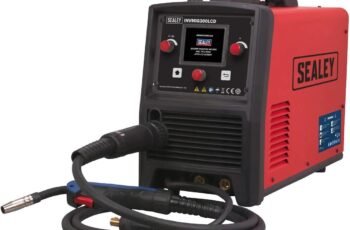Ad Blocker Detected
Our website is made possible by displaying online advertisements to our visitors. Please consider supporting us by disabling your ad blocker.
Portable welding machines are game-changers in industries like agriculture and construction. You can bring the repair shop to the site, cutting down on downtime. But there’s more to it than just convenience. These machines vary in cost, require skilled operators, and need regular maintenance. Environmental conditions can also affect weld quality. So, is the investment worth it? Let’s weigh the pros and cons to find out.
Advantages of On-Site Service Capability
On-site service capability offers several notable advantages, making it indispensable for industries relying on continuous operations.
You’ll experience reduced downtime as repairs are completed during business hours without moving equipment. On-site welders jump into action immediately, minimizing prolonged outages.
Time efficiency is another benefit, eliminating the need to relocate items to workshops or deal with transport logistics. Work begins promptly, with all necessary tools on hand.
Rapid mobilization becomes possible even in remote locations, keeping project timelines tight. Operational flexibility allows for repairs in diverse environments and accommodates sudden scope changes, minimizing disruption to ongoing operations. Moreover, specialized equipment available for handling difficult or unusual repair jobs ensures that tasks are completed with precision and quality.
Enhanced speed ensures dedicated attention to your project, avoiding the multitasking common in workshops, and reducing wait times significantly.
Cost Implications of Specialized Equipment
While on-site service capability offers numerous advantages, understanding the cost implications of specialized welding equipment is equally important for making informed decisions. Entry-level stick welders start around $100, but multiprocess units can exceed $10,000, reflecting their versatility across TIG, MIG, and Stick methods. Engine-driven models like the Hobart Champion Elite 225 offer a mix of welding power and generator capabilities, priced at about $4,899. Brand reputation, such as Miller or ESAB, often elevates prices, with advanced features like remote start/stop adding further costs. Additionally, MIG welders are a popular choice in industrial settings due to their ability to produce clean welds with minimal spatter. Ongoing expenses include consumables and safety gear, while maintenance and fuel costs affect engine-driven models. Promotions and rebates can offset these costs, so keep an eye out for deals to maximize your investment.
Response Time Benefits for Urgent Repairs
When urgent repairs arise, having the ability to respond quickly can make all the difference in maintaining industrial efficiency. Portable welding machines reduce downtime by enabling fast service, which prevents costly production halts.
These machines are especially beneficial in sectors like agriculture, construction, and marine, where delays impact entire operations. Mobile welding offers the convenience and accessibility needed for on-site service in critical environments. They allow same-day repairs, preserving project schedules in time-sensitive industries like pipelines.
Mobile welding offers immediate repair accessibility, addressing breakdowns on-site, even in remote locations. It eliminates the need for disassembly, tackling repairs in confined spaces like bridges.
On-site welding cuts job completion times by avoiding transport to workshops, ensuring quick operational restoration. Portable equipment matches stationary quality, providing durable welds and enabling rapid responses to unforeseen challenges.
Technical Expertise Requirements
Fast service from portable welding machines not only reduces downtime but also demands a high level of technical expertise. You need proficiency with advanced machinery like robotic welding systems and CNC plasma tables. Precision control is crucial, requiring you to adjust amperage and heat input for different materials. Your manual dexterity will be tested as you align components and manage fluxes. Setting up equipment for techniques like TIG or MIG involves configuring fixtures meticulously. Virtual reality training can enhance your skills, offering a safe space to practice complex scenarios. Moreover, understanding machine specifications, such as power supply compatibility and duty cycle analysis, ensures optimal machine performance. Your expertise is vital for maintaining quality and safety standards during welding operations. According to the Bureau of Labor Statistics, there are 47,600 job openings for welders projected annually until 2031, highlighting the significance of skilled professionals in this field.
Navigating Equipment Portability Challenges
Balancing the need for portability with the demand for robust performance presents unique challenges in the design and operation of portable welding machines. You need to consider the delicate interplay between weight, power, and durability. Compact designs shouldn’t compromise on welding capacity, demanding advanced engineering. Ergonomic handling is crucial; placing heavy components strategically reduces strain during transport. Multi-power compatibility ensures your machine operates with batteries, generators, or outlets, maintaining consistent performance. Impact-resistant casings protect against rough handling, while integrating compact components like inverters preserves functionality. Additionally, IoT connectivity will enable performance monitoring and remote diagnostics, enhancing the user experience. Operational complexity can slow you down; longer setup protocols and diverse welding requirements may demand rapid adjustments. Space constraints and lead-length limitations further complicate operations, especially in confined environments.
Precision and Material Waste Reduction
While striving for excellence in welding, achieving precision and reducing material waste is paramount. You can leverage AI-powered vision systems to maintain an impressive ±0.2 mm accuracy, which ensures consistent weld quality.
Laser welding systems are your ally in minimizing heat-affected zones, thus preserving material integrity, especially in aerospace components. Multi-joint robotic arms make welding in tight spaces feasible, cutting down on scrap from misalignment.
Real-time monitoring tools adapt parameters instantly, keeping you within specifications, while auto-correcting algorithms actively reduce errors and waste.
Versatile welding methods, like MIG and TIG, allow you to work with various materials without frequent equipment changes. Compact, handheld designs give you access to hard-to-reach areas, reducing the need for rework and saving both time and materials.
Maintenance Complexities and Solutions
Maintaining your portable welding machine can be a complex task, but understanding key maintenance practices ensures longevity and optimal performance. Start by regularly cleaning internal components with compressed air and wiping the exterior. Replace air/oil filters and clean gas sensors and torch tips to prevent slag buildup.
Adhere to duty cycle compliance by monitoring arcs and allowing cooldown periods. Install water-cooled systems for heavy operations and use cooling fans in hot environments.
Power management is crucial, so check power supply stability and voltage levels. Ensure cooling systems are unclogged and inspect ducts for airflow. Monthly, inspect cables for fraying and test connectors.
Store your machine in dry, dust-free conditions using weatherproof covers and silica gel desiccants. Keep a detailed maintenance log for service intervals.
Environmental Factors Impacting Performance
Environmental factors can greatly impact the performance of portable welding machines, affecting both the quality of welds and the safety of operators.
In cold temperatures, materials can become brittle, demanding arc stability adjustments. Slow cooling rates may lead to rigid welds prone to cracking, while high temperatures risk base metal overheating.
Wind disrupts shielding gases in MIG/TIG processes, causing porosity. You can use wind screens or increase gas flow rates to maintain arc stability.
Humidity poses risks of hydrogen-induced cracking; pre-drying materials and using metallized electrodes can help.
Contaminants like dust can lead to slag inclusion. Frequent cleaning and using flux-cored electrodes minimize contamination.
Operator fatigue increases in extreme temperatures, emphasizing the need for PPE and rotational staffing.
Conclusion
You’ve seen how portable welding machines can significantly boost on-site service capabilities and cut down response times for urgent repairs, especially in agriculture and construction. While the cost of advanced units can be high, having skilled operators ensures optimal performance and safety. Don’t forget, regular maintenance is crucial to keep these machines running smoothly. Be proactive about managing environmental factors and contaminants to maintain weld quality and efficiency, ultimately maximizing your investment.



